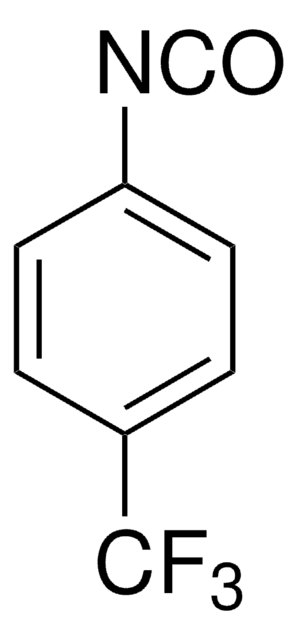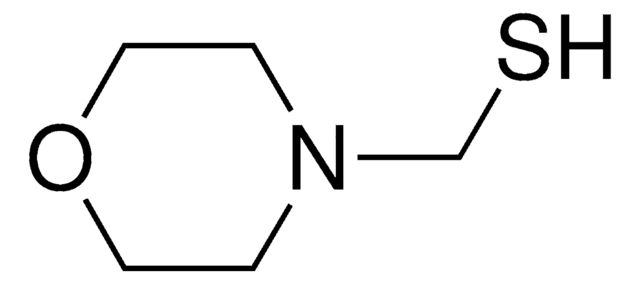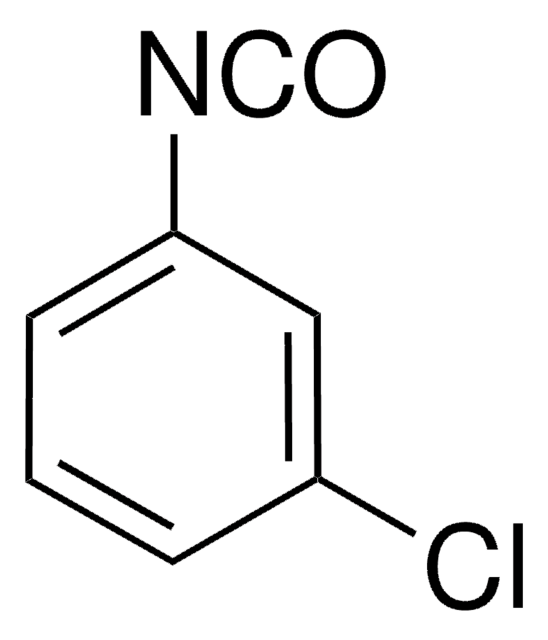374857
3,5-Bis(trifluoromethyl)phenyl isocyanate
98%
Synonyme(s) :
1-Isocyanato-3,5-bis(trifluoromethyl)benzene, 3,5-Di(trifluoromethyl)phenyl isocyanate
About This Item
Produits recommandés
Pureté
98%
Forme
liquid
Indice de réfraction
n20/D 1.43 (lit.)
Densité
1.476 g/mL at 25 °C (lit.)
Chaîne SMILES
FC(F)(F)c1cc(cc(c1)C(F)(F)F)N=C=O
InChI
1S/C9H3F6NO/c10-8(11,12)5-1-6(9(13,14)15)3-7(2-5)16-4-17/h1-3H
Clé InChI
NRSSOFNMWSJECS-UHFFFAOYSA-N
Catégories apparentées
Application
- Chemical derivatization of amino-functionalized model surfaces.
- Preparation of arylaminothiocarbonylpyridinium zwitterionic salts, via an exothermic reaction with 4-pyrrolidinopyridine.
- Synthesis of (S)-3-hydroxymethyl-2-methoxymethoxy-2′-(3-(3,5-bis(trifluoromethyl)phenyl)uryl-benzyl)-1,10-binaphthalene.
- Synthesis of 1-[3,5-bis(trifluoromethyl) phenyl]-3-(2-pyridyl)thiourea, via reaction with 2-amino pyridine in MeCN.
Mention d'avertissement
Danger
Mentions de danger
Conseils de prudence
Classification des risques
Acute Tox. 4 Dermal - Acute Tox. 4 Inhalation - Acute Tox. 4 Oral - Eye Irrit. 2 - Resp. Sens. 1 - Skin Irrit. 2 - Skin Sens. 1 - STOT SE 3
Organes cibles
Respiratory system
Code de la classe de stockage
6.1C - Combustible acute toxic Cat.3 / toxic compounds or compounds which causing chronic effects
Classe de danger pour l'eau (WGK)
WGK 3
Point d'éclair (°F)
154.4 °F - closed cup
Point d'éclair (°C)
68 °C - closed cup
Équipement de protection individuelle
Eyeshields, Faceshields, Gloves, type ABEK (EN14387) respirator filter
Certificats d'analyse (COA)
Recherchez un Certificats d'analyse (COA) en saisissant le numéro de lot du produit. Les numéros de lot figurent sur l'étiquette du produit après les mots "Lot" ou "Batch".
Déjà en possession de ce produit ?
Retrouvez la documentation relative aux produits que vous avez récemment achetés dans la Bibliothèque de documents.
Les clients ont également consulté
Notre équipe de scientifiques dispose d'une expérience dans tous les secteurs de la recherche, notamment en sciences de la vie, science des matériaux, synthèse chimique, chromatographie, analyse et dans de nombreux autres domaines..
Contacter notre Service technique












![1-[3,5-bis(trifluoromethyl)phenyl]-3-[(1R,2R)-(-)-2-(dimethylamino)cyclohexyl]thiourea AldrichCPR](/deepweb/assets/sigmaaldrich/product/structures/236/021/d944889d-2233-4700-9f2c-caa3652d0124/640/d944889d-2233-4700-9f2c-caa3652d0124.png)
![1,3-Bis[3,5-bis(trifluoromethyl)phenyl]thiourea](/deepweb/assets/sigmaaldrich/product/structures/191/427/0218c99c-65b9-4963-938c-c47a5790dfc5/640/0218c99c-65b9-4963-938c-c47a5790dfc5.png)
![(R)-N-[(1R,2R)-2-(3-(3,5-Bis(trifluoromethyl)phenyl)ureido)cyclohexyl]-tert-butyl-sulfinamide 96%](/deepweb/assets/sigmaaldrich/product/structures/389/070/18847164-c6a7-4b4e-abcb-2dbc22493a2d/640/18847164-c6a7-4b4e-abcb-2dbc22493a2d.png)